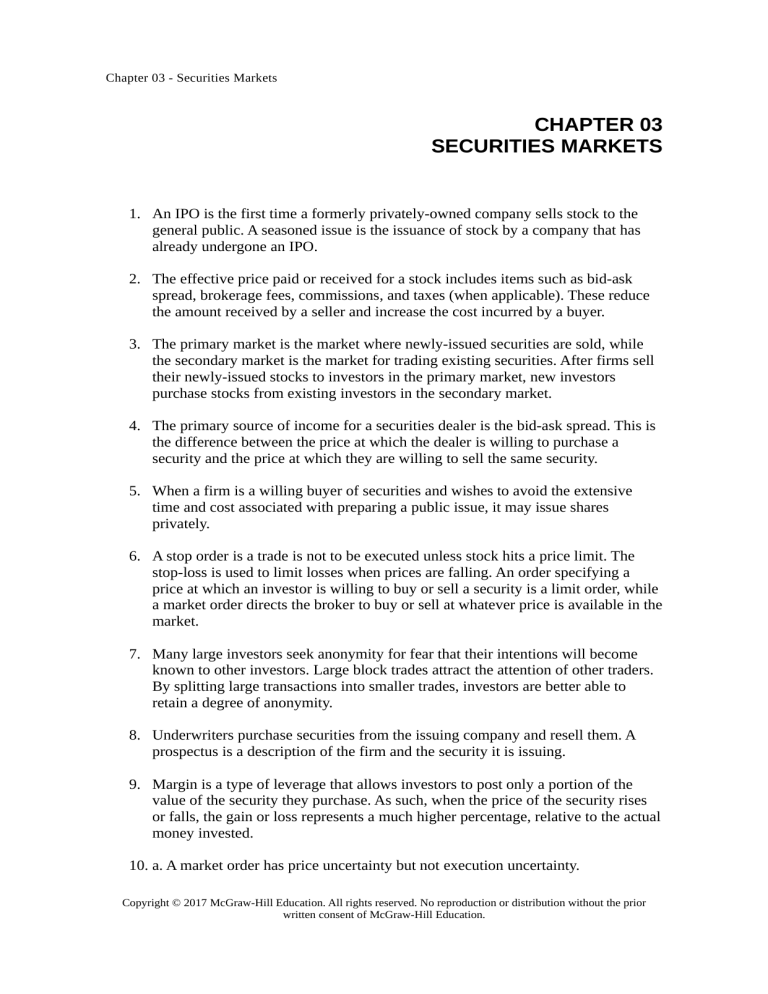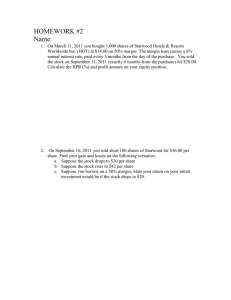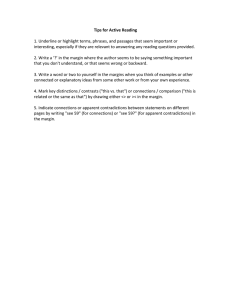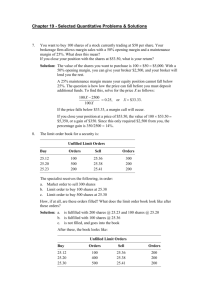
Chapter 03 - Securities Markets
CHAPTER 03
SECURITIES MARKETS
1. An IPO is the first time a formerly privately-owned company sells stock to the
general public. A seasoned issue is the issuance of stock by a company that has
already undergone an IPO.
2. The effective price paid or received for a stock includes items such as bid-ask
spread, brokerage fees, commissions, and taxes (when applicable). These reduce
the amount received by a seller and increase the cost incurred by a buyer.
3. The primary market is the market where newly-issued securities are sold, while
the secondary market is the market for trading existing securities. After firms sell
their newly-issued stocks to investors in the primary market, new investors
purchase stocks from existing investors in the secondary market.
4. The primary source of income for a securities dealer is the bid-ask spread. This is
the difference between the price at which the dealer is willing to purchase a
security and the price at which they are willing to sell the same security.
5. When a firm is a willing buyer of securities and wishes to avoid the extensive
time and cost associated with preparing a public issue, it may issue shares
privately.
6. A stop order is a trade is not to be executed unless stock hits a price limit. The
stop-loss is used to limit losses when prices are falling. An order specifying a
price at which an investor is willing to buy or sell a security is a limit order, while
a market order directs the broker to buy or sell at whatever price is available in the
market.
7. Many large investors seek anonymity for fear that their intentions will become
known to other investors. Large block trades attract the attention of other traders.
By splitting large transactions into smaller trades, investors are better able to
retain a degree of anonymity.
8. Underwriters purchase securities from the issuing company and resell them. A
prospectus is a description of the firm and the security it is issuing.
9. Margin is a type of leverage that allows investors to post only a portion of the
value of the security they purchase. As such, when the price of the security rises
or falls, the gain or loss represents a much higher percentage, relative to the actual
money invested.
10. a. A market order has price uncertainty but not execution uncertainty.
Copyright © 2017 McGraw-Hill Education. All rights reserved. No reproduction or distribution without the prior
written consent of McGraw-Hill Education.
Chapter 03 - Securities Markets
11. a. An illiquid security in a developing country is most likely to trade in broker
markets.
12.
a. In principle, potential losses are unbounded, growing directly with
increases in the price of IBX.
b. If the price of IBX shares goes above $210, then the stop-buy order would
be executed, limiting the losses from the short sale. If the stop-buy order
can be filled at $200, the maximum possible loss per share is $10. The
total loss is: $10 100 shares = $1000.
13. Answers to this problem will vary.
14.
a. In addition to the explicit fees of $60,000, we should also take into
account the implicit cost incurred to DRK from the underpricing in the
IPO. The underpricing is $4 per share, or a total of $400,000, implying
total costs of $460,000.
b. No. The underwriters do not capture the part of the costs corresponding to
the underpricing. However, the underpricing may be a rational marketing
strategy to attract and retain long-term relationships with their investors.
Without it, the underwriters would need to spend more resources in order
to place the issue with the public. The underwriters would then need to
charge higher explicit fees to the issuing firm. The issuing firm may be
just as well off paying the implicit issuance cost represented by the
underpricing.
15.
a. The stock is purchased for $40 300 shares = $12,000.
Given that the amount borrowed from the broker is $4,000, Dee’s margin
is the initial purchase price net borrowing: $12,000 – $4,000 = $8,000.
b. If the share price falls to $30, then the value of the stock falls to $9,000.
By the end of the year, the amount of the loan owed to the broker grows
to:
Principal (1 + Interest rate) = $4,000 (1 + 0.08) = $4,320.
The value of the stock falls to: $30 300 shares = $9,000.
The remaining margin in the investor’s account is:
Margin on long position =
Equity in a ccount
Value of s tock
Copyright © 2017 McGraw-Hill Education. All rights reserved. No reproduction or distribution without the prior
written consent of McGraw-Hill Education.
Chapter 03 - Securities Markets
=
$9,000 - $4,32 0
$9,000
= 0.52 = 52%
Therefore, the investor will not receive a margin call.
Ending e quity in a ccount - Initial equity in account
Initial e quity in a ccount
c. Rate of return =
=
$ 4 ,680 - $ 8 , 00 0
$ 8 ,000
= – 0.4150 = – 41.50%
16.
a. The initial margin was: $40 x 1,000 0.50 = $20,000.
As a result of the $10 increase in the stock price, Old Economy Traders
loses: $10 1,000 shares = $10,000.
Moreover, Old Economy Traders must pay the dividend of $2 per share to
the lender of the shares: $2 1,000 shares = $2,000.
The remaining margin in the investor’s account therefore decreases to:
$20,000 – $10,000 – $2,000 = $8,000.
b. Margin on short position =
=
Equity
Value of s hares o wed
$ 8,000
$ 50 1 ,000 shares
= 0.16 = 16%
Because the percentage margin falls below the maintenance level of 30%,
there will be a margin call.
Ending e quity - Initial equity
Initial e quity
c. The rate of return =
=
$ 8, 000 - $20,00 0
$ 2 0 ,000
= – 0.60 = – 60%
17.
a. The market-buy order will be filled at $50.25, the best price of limit-sell
orders in the book.
b. The next market-buy order will be filled at $51.50, the next-best limit-sell
order price.
Copyright © 2017 McGraw-Hill Education. All rights reserved. No reproduction or distribution without the prior
written consent of McGraw-Hill Education.
Chapter 03 - Securities Markets
c. As a security dealer, you would want to increase your inventory. There is
considerable buying demand at prices just below $50, indicating that
downside risk is limited. In contrast, limit-sell orders are sparse,
indicating that a moderate buy order could result in a substantial price
increase.
18.
a. Your initial investment is the sum of $5,000 in equity and $5,000 from
borrowing, which enables you to buy 200 shares of Telecom stock:
Initial i nvestment
Stock p rice
=
$10,000
$50
= 200 shares
The shares increase in value by 10%: $10,000 0.10 = $1,000.
You pay interest of = $5,000 0.08 = $400.
The rate of return will be:
$1 ,000 - $400
$5,000
= 0.12 = 12%
b. The value of the 200 shares is 200P. Equity is (200P – $5,000), and the
required margin is 30%.
Solving
200 P - $5,00 0
200 P
= 0.30, we get P = $35.71.
You will receive a margin call when the stock price falls below $35.71.
19.
a. Initial margin is 50% of $5,000, which is $2,500.
b. Total assets are $7,500 ($5,000 from the sale of the stock and $2,500 put
up for margin). Liabilities are 100P. Therefore, net worth is ($7,500 –
100P).
Solving
$7,50 0 -100 P
100 P
= 0.30, we get P = $57.69.
A margin call will be issued when the stock price reaches $57.69 or higher.
20. The broker is instructed to attempt to sell your Marriott stock as soon as the
Marriott stock trades at a bid price of $68 or less. Here, the broker will attempt to
execute but may not be able to sell at $68, since the bid price is now $67.95. The
price at which you sell may be more or less than $68 because the stop-loss
becomes a market order to sell at current market prices.
21.
a. The trade will be executed at $55.50.
b. The trade will be executed at $55.25.
Copyright © 2017 McGraw-Hill Education. All rights reserved. No reproduction or distribution without the prior
written consent of McGraw-Hill Education.
Chapter 03 - Securities Markets
c. The trade will not be executed because the bid price is lower than the price
specified in the limit-sell order.
d. The trade will not be executed because the asked price is higher than the
price specified in the limit-buy order.
22.
a. You will not receive a margin call. You invest in 1,000 shares of Ixnay at
$40 per share with $20,000 in equity and $20,000 from borrowing. At $35
per share, the value of the stock becomes $35,000. Therefore, the equity
decreases to $15,000:
Equity = Value of stock – Debt = $35,000 – $20,000 = $15,000
Percentage margin =
=
Equity in a ccount
Value of s tock
$15,000
$35,000
= 0.4286 or 42.86%
The percentage margin still exceeds the required maintenance margin.
b. Solving
1,00 0 P - $ 20,000
1,000 P
= 0.35 or 35%, we get P = $30.77
You will receive a margin call when the stock price falls to $30.77 or
lower.
23. The proceeds from the short sale (net of commission) were:
($21 100) – $50 = $2,050.
A dividend payment of $300 was withdrawn from the account. Covering the short
sale at $15 per share costs (including commission): $1500 + $50 = $1550.
Therefore, the value of your account is equal to the net profit on the transaction:
$2,050 – $300 – $1,550 = $200.
Noted that the profit of $200 equals (100 shares x profit per share of $2), your net
proceeds per share were:
$21
–$15
–$ 3
–$ 1
$ 2
Selling price of stock
Repurchase price of stock
Dividend per share
2 trades x $0.50 commission per share
24. The total cost of the purchase is: $40 500 = $20,000.
Copyright © 2017 McGraw-Hill Education. All rights reserved. No reproduction or distribution without the prior
written consent of McGraw-Hill Education.
Chapter 03 - Securities Markets
Investing $15,000 from your own funds and borrowing $5,000 from the broker,
you start the margin account with the net worth of $15,000.
a.
(i) Net worth increases to: ($44 500) – $5,000 = $17,000
Percentage gain = ($17,000 – $15,000)/$15,000 = 0.1333 = 13.33%
(ii) With price unchanged, net worth is unchanged.
Percentage gain = zero
(iii) Net worth falls to ($36 500) – $5,000 = $13,000
Percentage gain = (($13,000 – $15,000)/$15,000 = –0.1333 = –13.33%
The relationship between the percentage return and the percentage change
in the price of the stock is given by:
% return = % change in price
Total i nvestment
Investor 's i nitial e quity
= % change in price 1.3333
For example, when the stock price rises from $40 to $44, the percentage
change in price is 10% (0.10), while the percentage gain for the investor
is:
% return = 0.10
$2 0 ,000
$15,000
= 0.1333 or 13.33%
b. The value of the 500 shares is 500P. Equity is (500P – $5,000). You will
receive a margin call when:
500 P - $5,000
50 0 P
= 0.25 or 25%, when P = $13.33 or lower.
c. The value of the 500 shares is 500P. But now you have borrowed $10,000
instead of $5,000. Therefore, equity is (500P – $10,000). You will receive
a margin call when:
500 P - $10 ,000
50 0 P
= 0.25 or 25% when P = $26.67.
With less equity in the account, you are far more vulnerable to a margin
call.
d. By the end of the year, the amount of the loan owed to the broker grows
to:
$5,000 (1 + 0.08) = $5,400
Copyright © 2017 McGraw-Hill Education. All rights reserved. No reproduction or distribution without the prior
written consent of McGraw-Hill Education.
Chapter 03 - Securities Markets
The equity in your account is (500P – $5,400). Initial equity was $15,000.
Therefore, the rate of return after one year is as follows:
(i)
(500 $44) - $5,400 - $15,000
$15,000
= 0.1067 = 10.67%
(ii)
(500 $40) - $5,400 - $15,000
$15,000
= –0.0267 = –2.67%
(iii)
(500 $36) - $5,400 - $15,000
$15,000
= –0.1600 = –16.00%
The relationship between the percentage return and the percentage change
in the price of XTel is given by:
% return =
Total investment
(% change in price Investor's
initial equity )
–
Funds borrowed
Investor's initial equity
(8%
)
For example, when the stock price rises from $40 to $44, the percentage
change in price is 10% (0.10), while the percentage gain for the investor
is:
(. 10 $15$20,000
,000 )
–
(.0 8 $1$5,000
5 ,000 )
= .1067 or 10.67%
e. The value of the 500 shares is 500P. Equity is (500P – $5,400). I will
receive a margin call when:
500 P - $5,400
50 0 P
= 0.25 or 25% when P = $14.40 or lower.
25.
a. Given the $15,000 invested funds and assuming the gain or loss on the
short position is (–500 P), we can calculate the rate of return using the
following formula:
Rate of return = (–500 P)/15,000
Thus, the rate of return in each of the three scenarios is:
(i) Rate of return = (–500 $)/$15,000 = –0.1333 = –13.33%
(ii) Rate of return = (–500 $)/$15,000 = 0%
(iii) Rate of return = [–500 (–$4)]/$15,000 = 0.1333 = 13.33%
Total assets on margin are the sum of the initial margin and the proceeds
from the sale of the stock:
Copyright © 2017 McGraw-Hill Education. All rights reserved. No reproduction or distribution without the prior
written consent of McGraw-Hill Education.
Chapter 03 - Securities Markets
$20,000 + $15,000 = $35,000. Liabilities are 500P. A margin call will be
issued when:
$35,000 -500 P
500 P
= 0.25 or 25% when P = $56 or higher.
b. With a $1 dividend, the short position must now pay on the borrowed
shares: ($1/share 500 shares) = $500. Rate of return is now:
[(–500 P) – 500]/15,000
(i) Rate of return =[(–500 $4) – $500]/$15,000 = –0.1667 = –16.67%
(ii) Rate of return = [(–500 $0) – $500]/$15,000 = –0.0333 = –3.33%
(iii) Rate of return = [(–500) (–$4) – $500]/$15,000 = 0.1000 = 10.00%
Total assets are $35,000, and liabilities are (500P + 500). A margin call
will be issued when:
$35,000 -500 P - 500
500 P
= 0.25 or 25% when P = $55.20 or higher.
CFA 1
d. Cannot tell from the information given.
The broker will start to sell when the stock price hits $55 and keep doing so if the
price further tumbles.
CFA 2
d. Act as odd-lot dealers.
Copyright © 2017 McGraw-Hill Education. All rights reserved. No reproduction or distribution without the prior
written consent of McGraw-Hill Education.







